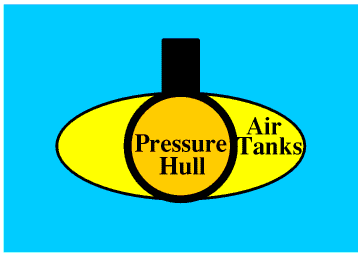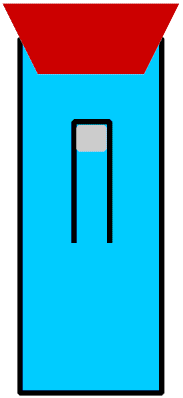Submarines are designed to be capable of operating on the surface or under it (submerged). They consist of a watertight pressure hull and on the outside of this there are large air tanks. When these contain air the submarine has enough buoyancy to float but when they are filled with water the submarine will sink.
To read more about buoyancy please click here ![]() and to read about surface ships please click here
and to read about surface ships please click here ![]()

The crew live and work inside the pressure hull. It must be strong enough to withstand the pressure of the water at the depth the submarine is designed to operate.
When the air tanks are full of air the submarine will float - usually submarines are designed to float on the surface quite low in the water (only a little freeboard). When the submarine dives (submerges) water is let into the tanks; to surface again air is blown into them. This air must be stored inside the submarine in compressed air tanks. If the submarine submerges with its compressed air tanks empty it will not be able to surface again, so once it has surfaced the very first thing it must do is to start refilling them.
Water is incompressible - this means that, unlike air, when you increase the pressure you do not change the volume. This in turn means that although the pressure increases as you go deeper under the sea the density of the water does not change, and this means that if the submarine's buoyancy is less than its weight at one depth it will also be less than its weight at any other depth, and so, unless other forces are involved, when water is let into the air tanks the submarine will sink right to the bottom of the sea no matter how deep it is. You can demonstrate this for yourself by making a Cartesian Diver - the instructions can be found in the next section.
In order to be able to stay submerged at a constant depth larger submarines are fitted with hydrofoils (or hydroplanes) like the wings of an aircraft. The angle of these can be adjusted so as to provide an upward or downward force to control the depth, and also the angle, of the submarine in the water, but only if the submarine is moving forward through the water fast enough for the hydroplanes to produce a big enough force. These hydroplanes are sometimes folded away or retracted when the submarine is on the surface, particularly when it is in harbour or dock, so you cannot always see them very clearly on photographs.
A submarine can be detected by the noise it makes as it is propelled through the water. Designers of military submarines are always trying to reduce this noise, and this means making a submarine controllable at lower and lower speeds and developing ever quieter methods of propulsion. The film The Hunt for Red October was about a Russian submarine that was equipped with a totally silent propulsion system.
Smaller submarines, particularly those used for research and rescue purposes and for recreation and sport, are usually fitted with electric motors driving propellors which can be swivelled to provide a force in any direction and so provide both propulsion and control.
You can see some pictures of submarines by visiting the Submarine Photo Gallery web site ![]()

Now carry out your own experiments with the diver. See if you can get the diver to stay in the middle for longer than ten seconds without you touching the bung.
Fishes can stay at a constant depth in water because all the time they are making minute movements with their fins and tail and adjustments to their buoyancy - if a fish dies it will either sink to the bottom or float to the surface. Similarly human beings can stand upright on two legs because all the time they are making very tiny movements with the muscles of their legs and back - they do not need to think about this of course, but if they stop making them, for example by falling asleep, they will fall over.
© Barry Gray April 2016